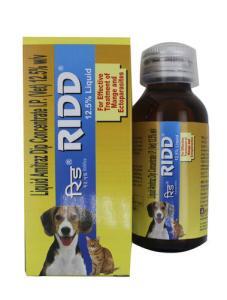Table of Contents
RIDD is a medicine used in veterinary to control external parasites in pets. It is commonly used to treat infestations of ticks, mites, and lice in animals. Amitraz belongs to a class of compounds called formamidines and works by interfering with the nervous system of the parasites.

What Is RIDD (Amitraz)?
When used as directed by a veterinarian, RIDD can effectively manage parasitic infestations in pets. Addressing parasitic infestations in pets is crucial for their health, the prevention of diseases, their comfort, and the well-being of both the pets and the surrounding environment. Regular amitraz treatment for demodectic mange in dogs and preventive measures, such as using appropriate medications and practicing good hygiene, can significantly reduce the risks associated with these parasites.
Ingredients
Liquid Amitraz Concentrate L.P. (Vet) 12,5% w/v
Produced in bottles of 6ml, 15ml, and 60 ml.
Forms of Amitraz
It is available in various forms for pet use, including the following.
Liquid
Amitraz dip concentrate liquid for dogs can be applied topically to the pet’s skin. The liquid formulation is usually applied to specific areas or spots as a veterinarian directs. Ask your veterinarian how to apply Amitraz to the dog.
Soap
Amitraz soap for dogs is used for bathing and controlling external parasites. The soap is lathered onto the pet’s coat and rinsed off after a specified period to complete an amitraz bath for dogs. Read the label to know how to use Amitraz soap for dogs.
Spray
Amitraz spray for dogs is designed to be directly applied onto the pet’s coat. It provides a convenient method of medication administration and helps control external parasites.
Collar
Amitraz collars for dogs, such as the Amitraz tick collar, are worn by pets and provide long-lasting protection against ticks, fleas, and other external parasites. The active ingredient is gradually released from the collar, offering continuous control over an extended period.
Shampoo
Amitraz shampoo for dogs is used during bathing to control external parasites. The shampoo is lathered onto the pet’s coat, allowed to remain for a specified time, and then rinsed off.
Injections
Amitraz injections for dogs are administered by a veterinarian for specific medical purposes, such as treating certain types of mite infestations. Injections are typically given under professional supervision.
It’s important to note that the availability of specific forms may vary depending on your region or country. Check with your veterinarian about Amitraz for dogs Philippines or Amitraz for dogs UK. Additionally, the appropriate form and Amitraz for dogs dose should be determined by a veterinarian based on the specific condition being treated. Always consult a veterinarian before using any medication on your pet.
Uses of RIDD
What is Amitraz used for? And what is Amitraz for dogs and cats?
RIDD is typically used in pets to treat and control specific external parasite infestations, particularly ticks, mites, and lice. The specific indications for using this medicine can vary depending on the type of parasite and the pet’s circumstances. Here are some common situations where it may be used:
- This medication is often used to control ticks in dogs. Suppose your dog has a tick infestation or is at risk of tick exposure due to their environment or lifestyle. Your veterinarian may recommend a RIDD solution to help eliminate the ticks and prevent future infestations.
- RIDD can be used to treat certain types of mite infestations in dogs. These include demodectic mange caused by Demodex mites and sarcoptic mange caused by Sarcoptes mites. A veterinarian may prescribe treatment with RIDD based on the severity and type of mite infestation.
- This medication is effective against lice infestations in dogs. If your dog is infested with lice, your veterinarian may recommend RIDD to eradicate the parasites.
Who Can Use Amitraz?
It is primarily used in veterinary medicine and approved for specific species. Here’s a breakdown of the approved uses.
Medicine for Dogs
As mentioned, RIDD is commonly used in dogs to control tick infestations and certain types of mite infestations, such as demodectic mange and sarcoptic mange.
RIDD for Cats
Cats are generally more sensitive to this active ingredient; use caution when administering RIDD solutions for cats. Consult a veterinarian for appropriate recommendations specific to cats.
Amitraz for Farm Animals
While this medication is primarily used in dogs, there may be instances where it is used in farm animals, such as cattle or sheep. The use of this medicine in farm animals is typically under the guidance and prescription of a veterinarian with knowledge and experience in livestock medicine and using the drug for goats, hamsters, and pigs.

Dosage Sizes
How to use Amitraz solution 12.5 for dogs?
Applying a diluted mixture of 2ml per liter of water is recommended to effectively control ticks and fleas in pets using the RIDD solution. A slightly stronger solution of 3-4ml per liter of water should be used for mange treatment. Follow the recommended dilution ratios on how to use amitraz solution for dogs and apply it once a week for optimal results in managing these external parasites.
Here are some general steps for applying the solution to pets:
- Carefully read and understand the instructions provided with the RIDD solution you are using. Pay attention to the recommended dosage, application method, and specific precautions or warnings.
- Ensure that your pet is calm and comfortable before application. If needed, have another person assist you in restraining the pet gently and safely during the application process.
- To protect your skin, wearing disposable gloves while handling the solution is recommended.
- Follow the specific application method recommended for the particular product you are using. It may involve a topical application, such as spot-on treatment or spraying, or immersion in a diluted solution. Apply the solution directly to the targeted areas or as the manufacturer or veterinarian instructed.
- Avoid getting the solution into your pet’s eyes, mouth, or open wounds. If accidental contact occurs, rinse thoroughly with clean water.
Remember, it is always best to consult a veterinarian for specific guidance on applying the solution to your pet.
Important Safety Information for Owners
Pet owners must be aware of the following safety information to know if Amitraz is harmful to animals.
Ensure that you use the correct dosage, application method, and frequency of use for your specific pet.
Prevent RIDD solution from contacting your pet’s eyes, mouth, or open wounds. If accidental contact occurs, rinse thoroughly with clean water and seek veterinary advice.
After applying the medication, observe your pet for any signs of adverse reactions, such as excessive salivation, lethargy, tremors, or difficulty breathing. If you notice any concerning symptoms, contact your veterinarian immediately.
The use of this drug in pregnant animals should be cautiously approached, and it is best to consult a veterinarian before applying any medication. The safety of Amitraz during pregnancy has not been extensively studied in pets, and its use may carry potential risks.
Remember, every pet is unique, and their medication response can vary. Prioritizing your pet’s safety using RIDD, following professional advice, and closely monitoring their well-being during and after the application is essential.
Veterinary Prescription
Do you need a prescription for Amitraz dip for dogs?
In most cases, you will need a veterinary prescription to purchase this medicine for your pet. It is a prescription medication, and a veterinarian should supervise its use. This requirement helps ensure the medication is used appropriately and safely for your pet’s needs.
Check with the veterinarian if RIDD is over–the–counter medicine in your area or not.
Contraindications
RIDD has several contraindications and should not be used under certain conditions. Here are some common contraindications associated with this medicine.
If your pet has a known hypersensitivity or allergy to Amitraz or any of the ingredients in RIDD, its use is contraindicated. Allergic reactions can range from mild to severe, including skin irritation, itching, swelling, difficulty breathing, or anaphylaxis. If your pet has a history of adverse reactions to RIDD or similar medications, alternative treatment options should be explored.
The use of RIDD in pregnant or nursing animals may not be advisable. There is limited information available on the safety of this drug in these situations, and potential risks to the developing fetus or nursing offspring are a concern.
It should not be applied to animals with extensive skin injuries, open wounds, or dermatitis. The solution can cause further irritation, delay healing, or enter the bloodstream, potentially leading to systemic effects. These conditions should be treated and resolved before considering the use of RIDD.
Consult a veterinarian before using this medication or any other medication on your pet.
Side Effects
RIDD can cause side effects in pets, and it’s essential to be aware of them when using this medication. The following are potential side effects for dogs that have been reported:
- Sedation: One of its most common side effects is sedation or drowsiness. Pets may appear lethargic, have reduced energy levels, or exhibit decreased activity.
- Lethargy and Weakness: RIDD can cause general lethargy and weakness in pets. They may seem less active or have reduced muscle strength temporarily.
- Incoordination: Some pets may experience temporary incoordination or difficulty with movements, such as stumbling or unsteady walking.
- Loss of Appetite: Its use has been associated with a temporary decrease in appetite in some pets. They may have reduced interest in food, or exhibit decreased eating.
- Gastrointestinal Upset: Digestive disturbances such as vomiting or diarrhea have been reported in some animals after its use. These symptoms are usually self-limiting and resolve without intervention.
- Skin Reactions: In rare cases, pets may develop localized skin reactions at the application site, such as redness, itching, or irritation. If severe or persistent, veterinary attention should be sought.
- Changes in Body Temperature: RIDD can affect body temperature regulation in some pets. They may experience fluctuations in body temperature, leading to either hypothermia (low body temperature) or hyperthermia (high body temperature).
These side effects are generally mild and transient. However, if you observe any concerning or persistent symptoms after using the medicine, it is recommended to consult a veterinarian.
Remember to use the solution strictly as directed by your veterinarian or the product instructions, and inform your veterinarian of any pre-existing medical conditions or medications your pet takes to ensure their safety and well-being.
Overdose
An overdose of RIDD in pets can have severe consequences and requires immediate veterinary attention. If you suspect an overdose or accidental ingestion of the medication by your pet, it is essential to seek veterinary care without delay. Here are some potential signs and symptoms of an overdose:
- An overdose can lead to excessive sedation or depression in pets. They may appear extremely lethargic, unresponsive, or have difficulty staying awake.
- Overdose can cause a significant decrease in heart rate, known as bradycardia. You may notice that your pet’s heart rate is abnormally slow or irregular.
- RIDD overdose can lower body temperature, resulting in hypothermia. Your pet may feel unusually cold to the touch or exhibit signs of shivering and discomfort.
- Breathing difficulties, such as slowed or shallow breathing, can occur in overdose cases.
- Excessive ingestion of RIDD may lead to vomiting and diarrhea, further contributing to dehydration and electrolyte imbalances.
- Pets experiencing an overdose may exhibit incoordination, weakness, or difficulty walking or standing.
Do not induce vomiting or administer home remedies without veterinary guidance if you suspect an overdose. Contact your veterinarian immediately or, if necessary, seek emergency veterinary care. Be prepared to provide information on the suspected amount of the product ingested, the time of ingestion, and any observed symptoms.
Prompt veterinary intervention is crucial in managing an overdose to minimize potential complications and ensure the best possible outcome for your pet’s health and well-being.
Amitraz Poisoning
Amitraz poisoning in pets can occur if they ingest (Amitraz ingestion in dogs) or are exposed to excessive amounts of the substance. Amitraz intoxication in dogs is a serious situation that requires immediate veterinary attention.
The symptoms of RIDD poisoning can vary depending on the amount ingested and the individual pet’s sensitivity. Common signs and symptoms may include excessive sedation, lethargy, weakness, disorientation, slow heart rate (bradycardia), low body temperature (hypothermia), respiratory depression, vomiting, diarrhea, tremors, and in severe cases, seizures or coma.
If you suspect or have confirmed that your pet has been poisoned by RIDD, it is crucial to seek immediate veterinary care. Contact your veterinarian or an emergency veterinary clinic immediately and follow their guidance.
The treatment for toxicity of Amitraz for dogs will depend on the severity of the symptoms and the amount of the medicine ingested. It may involve inducing vomiting (if the ingestion was recent and advised by a veterinarian), administering activated charcoal to absorb the toxin, providing supportive care to stabilize the pet’s vital signs, and monitoring for complications. In severe cases, hospitalization and intensive care may be necessary.
It is crucial to act quickly if you suspect poisoning in your pet.
Ask about the antidote for Amitraz poisoning in dogs before purchasing Amitraz for dogs.
Storage
RIDD solution should be stored in a cool, dry place away from direct sunlight and extreme temperatures. Store it in a secure location that is out of reach of children and pets. Consider using a locked cabinet or shelf to prevent accidental access or ingestion. Keeping medication in its original packaging is generally recommended, as it provides important information about the product and helps protect it from external factors that may affect its stability. Store RIDD away from food, beverages, or other items that may become contaminated if accidental spillage or leakage occurs.
Always refer to the specific storage instructions provided by the manufacturer or consult your veterinarian for any additional recommendations regarding the proper storage of the medicine. Following the storage guidelines will help maintain the quality and effectiveness of the product and ensure its safety for future use.
Generic and Brand Names of RIDD (Amitraz)
What is the chemical formula for Amitraz?
Amitraz is an active ingredient used by RIDD to control parasites. It is available under different generic and brand names. Here are some examples:
Generic Names
Amitraz: This is the generic name for the active ingredient itself. It is the chemical name used to identify the compound.
Other Brand Names
- Mitaban: Mitaban is a commonly known brand name used specifically for treating demodectic mange in dogs.
- Preventic: Preventic is another brand name collars used to control ticks and fleas in dogs.
- TriTak: TriTak is a brand name for a spot-on solution that controls ticks, fleas, and mites in dogs.
Availability and brand names may vary depending on the region or country. Always consult your veterinarian or check the product labels for the specific brand names available in your area.
Other Drugs in the Same Class
Amitraz belongs to a class of drugs known as formamidines or amidines. While it is primarily used in veterinary medicine, other drugs in the same class have different applications. Here are a few examples:
- Doramectin: Doramectin is an antiparasitic medication used primarily in veterinary medicine. It belongs to the macrocyclic lactone class of drugs and is commonly used to treat and prevent various internal and external parasites in livestock.
- Ivermectin: Ivermectin is another member of the macrocyclic lactone class and is widely used in veterinary medicine. It is used to treat and control a broad range of parasites in various species, including livestock, horses, dogs, and cats. Ivermectin is also used in human medicine to treat certain parasitic infections.
- Propoxur: Propoxur is an insecticide and acaricide used to control various insects and ticks. It acts on the nervous system of the parasites and is used in both human and veterinary applications.
- Chlorhexidine: Chlorhexidine is an antiseptic and disinfectant agent commonly used in both human and veterinary medicine. It is effective against a wide range of bacteria, fungi, and some viruses. Chlorhexidine is used for wound care, surgical site preparation, and in oral hygiene products.
While these drugs may belong to the same class, they may have different mechanisms of action and specific uses.
Comparing Amitraz to other Active Ingredients
Contact professionals to learn benefits of this medicine and determine the most appropriate active ingredient and treatment plan for your pet’s specific condition. They will consider factors such as the type of parasite, the extent of the infestation, and your pet’s overall health to determine the best course of action.
Sulfurated Lime
| Amitraz | Sulfurated Lime | |
|---|---|---|
| Mode of Action | Acts on the nervous system of parasites | Damages cell walls of parasites and fungi |
| Uses | Treatment and prevention of ticks, fleas, and mites in dogs |
Treatment of sarcoptic mange, demodectic mange, ringworm and other skin infections |
| Veterinary Guidance | Should be used under veterinary guidance for proper usage and safety |
Should be used under veterinary guidance for appropriate usage and safety precautions |
| Safety and Side Effects |
Possible side effects include sedation, lethargy, gastrointestinal upset, and skin irritation |
Possible side effects include skin irritation, dryness, temporary fur discoloration |
| Formulations | Spot-on solutions, sprays, collars, shampoos, etc. |
Topical solutions or dips |
Please note that this table compares the drug and Sulfurated Lime. It doesn’t show which is better, sulfurated lime or Amitraz for dogs. Individual product formulations may have specific variations or additional considerations.
FAQ
Does Amitraz Kill Fleas and Ticks?
Yes, it effectively kills and controls fleas and ticks in dogs. It acts on the nervous system of these parasites, disrupting their normal function and leading to their elimination.
Does It Expire?
Yes, these products have an expiration date. Check the expiration date before using the product, and do not use it beyond that date. Expired products may be less effective and could be less safe.
How Do I Apply the Solution to My Dog?
Spot-on solutions are applied directly to the skin between the shoulder blades or along the back, while sprays and shampoos are used to wet the coat thoroughly. Carefully follow the instructions provided with the product or consult with your veterinarian for proper application guidelines.
How Does Amitraz Work?
It works by interfering with the nervous system of parasites. It binds to specific receptors on the parasites’ nerve cells, disrupting normal neurotransmission. This disrupts vital functions in the parasites, ultimately causing their paralysis and death.
Should I Use It Once or Twice a Day for a Dog?
The frequency of application can vary depending on the specific product and the condition being treated. Follow the instructions the manufacturer or your veterinarian provided regarding the recommended application frequency. In most cases, these products are applied once a week for tick and flea control, but for specific conditions like mange, the frequency may be different.
Where to Buy Amitraz for Dogs and Cats?
These products for dogs and cats can be found for sale in various sources, including veterinary clinics, pet supply stores, and online retailers. Ensure that you are purchasing from a reputable source and that the product is specifically labeled for use in dogs or cats. Check how much Amitraz is for dogs in your local veterinarian. Amitraz for dogs price can also be found in the online vet pharmacy.
Is Amitraz Safe for Dogs and Cats?
It can be safe for dogs and cats when used according to the recommended dosage and instructions. However, individual pets may have different sensitivities or reactions to the product.
Olivia Bennet is a veterinarian who has worked in a veterinary clinic for many years. She specializes in the diagnosis, disease prevention, and treatment of not only cute kittens and puppies but also large farm animals. Olivia loves animals, cares about them, and wants to help you know more about your pets.

































